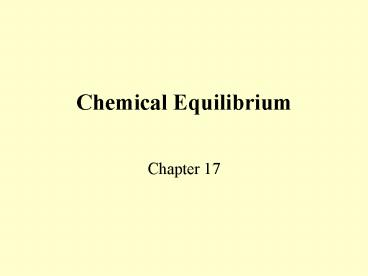Chemical Equilibrium - PowerPoint PPT Presentation
1 / 15
Title:
Chemical Equilibrium
Description:
Chemical Equilibrium Chapter 17 Chemical Equilibrium Chemical Equilibrium is a state of dynamic balance where the rate of the forward reaction is equal to the rate of ... – PowerPoint PPT presentation
Number of Views:168
Avg rating:3.0/5.0
Title: Chemical Equilibrium
1
Chemical Equilibrium
- Chapter 17
2
Chemical Equilibrium
- Chemical Equilibrium is a state of dynamic
balance where the rate of the forward reaction is
equal to the rate of the reverse reaction.
3
Le Chateliers Principle
- When a system in equilibrium is subjected to a
stress, the system readjusts to relieve the
effect of the stress. - Stresses include Pressure, Temperature,
Concentration of one or more reactants. - Leaving Cert 2008 Q7, 2007Q10a, 2006 Q11b,2005 Q9
2004 Q9(C) 2003 Q11 2002 Q10(C)
4
Experiments to investigate Le Chateliers
principle using 3 named experiments.
- Example 1
- Cobalt (II) Chloride, conc HCL.
- CoCl42- 6H2O
Co(H2O)62 4Cl- - Blue Red
- Addition of HCl -
- Addition of Water -
- Addition of Heat
- Exothermic
- CoCl42- 6H2O Co(H2O)62 4Cl-
- Increase in temperature- goes from red to blue
therefore the reaction is ?
Red to Blue
Goes Blue to Red
Exothermic
5
Example 2
- Sodium Dichromate
- Cr2O72 H2O 2CrO42 2H
- Orange Yellow
- Addition of an alkali(NaOH)-
- Why?
- Addition of an acid (HCL)-
- Why?
Orange changes to Yellow
Yellow to Orange
6
Example 3
7
Industrial Applications of Le Chatellier
- Manufacture of Ammonia(NH3) by the Haber Process
- N2 3H2 --gt 2NH3
- According to Le Chatelier a high pressure and low
temperature are the best conditions to give a
maximum yield of ammonia. - In practice
- the reaction is carried out at a pressure of 200
atmospheres and a temperature of 500 C with an
Iron catalyst.
8
HABER PROCESS
9
HABER PROCESS
N2(g) 3H2(g) 2NH3(g)
DH - 92 kJ mol-1 Conditions Pressure 200
00 kPa (200 atmospheres) Temperature 380-450C
Catalyst iron Equilibrium theory favours low
temperature exothermic reaction - higher
yield at lower temperature high pressure
decrease in number of gaseous molecules Kinetic
theory favours high temperature greater
average energy more frequent collisions high
pressure more frequent collisions for
gaseous molecules catalyst lower
activation energy Compromise conditions Which is
better? A low yield in a shorter time
or a high yield over a longer period. The
conditions used are a compromise with the
catalyst enabling the rate to be kept up, even at
a lower temperature.
10
IMPORTANT USES OF AMMONIA AND ITS
COMPOUNDS MAKING FERTILISERS 80 of the ammonia
produced goes to make fertilisers such
as ammonium nitrate (NITRAM) and ammonium
sulphate NH3 HNO3 gt NH4NO3
2NH3 H2SO4 gt
(NH4)2SO4 MAKING NITRIC ACID ammonia can be
oxidised to nitric acid nitric acid is used
to manufacture... fertilisers (ammonium
nitrate) explosives (TNT) polyamide
polymers (NYLON)
11
Example 2
- Manufacture of Sulfuric Acid by the Contact
process. - Exothermic
- 2SO2 O2 2SO3
- What Conditions give the best Yield?
- According to Le Chatelier a high pressure and low
temperature are the best conditions to give a
maximum yield of sulphur trioxide. - In practice the reaction is carried out at a
pressure of 1 atmospheres and a temperature of
45O C with a Vanadium Pentoxide (V2O5)catalyst.
12
The Equilibrium constant(Kc)
- Provided the Temperature remains constant there
is a - relationship between the concentration of the
reactants and - products in a equilibrium mixture. This constant
is based on the - law of Chemical Equilibrium.
- If
- Therefore
- Only a change in temperature changes the value of
Kc
13
Example
- Write the equilibrium constant expression (Kc)
for the following equation. - Answer
- Calculations involving the law of Chemical
Equilibrium -
(See BOOK pages 242-245) - Two types (a) Calculate KC (2004 Q 9)
- (b) Given KC calculate the
equilibriumconcentrations
(Revised sample paper Feb 2002 Q.9) - Leaving Cert 2005 Q9(C) 2004 Q9(C) 2003 Q11 2002
Q10(C)
14
Question 7 2010 paper Find KC
15
Given KC find the equilibrium concentrations. 200
3 Q11(a)































